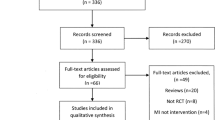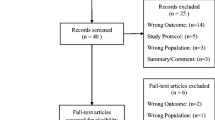Abstract
Summary
We have designed an innovative randomized controlled trial for improving adherence with osteoporosis medications. Recruitment and randomization have been successful. Also, the counseling intervention has been well accepted by subjects randomized to this treatment arm.
Introduction
While many effective treatments exist for osteoporosis, most people do not adhere to such treatments long term. No proven interventions exist to improve osteoporosis medication adherence. We report here on the design and initial enrollment in an innovative randomized controlled trial aimed at improving adherence to osteoporosis treatments.
Methods
The trial represents a collaboration between academic researchers and a state-run pharmacy benefits program for low-income older adults. Beneficiaries beginning treatment with a medication for osteoporosis are targeted for recruitment. We randomize consenting individuals to receive 12 months of mailed education (control arm) or an intervention consisting of one-on-one telephone-based counseling and the mailed education. Motivational interviewing forms the basis for the counseling program which is delivered by seven trained and supervised health counselors over ten telephone calls. The counseling sessions include scripted dialog and open-ended questions about medication adherence and its barriers, as well as structured questions. The primary end point of the trial is medication adherence measured over the 12-month intervention period. Secondary end points include fractures, nursing home admissions, health care resource utilization, and mortality.
Results
During the first 7 months of recruitment, we have screened 3,638 potentially eligible subjects. After an initial mailing, 1,115 (30.6%) opted out of telephone recruitment and 1,019 (28.0%) could not be successfully contacted. Of the remaining, 879 (24.2%) consented to participate and were randomized. Women comprise over 90% of all groups; mean ages range from 77 to 80 years old, and the majority in all groups was white. The distribution of osteoporosis medications was comparable across groups and the median number of different prescription drugs used in the prior year was eight to ten.
Conclusions
We have developed a novel intervention for improving osteoporosis medication adherence. The intervention is currently being tested in a large-scale randomized controlled trial. If successful, the intervention may represent a useful model for improving adherence to other chronic treatments.

Similar content being viewed by others
References
Wolf RL, Zmuda JM, Stone KL, Cauley JA (2000) Update on the epidemiology of osteoporosis. Curr Rheumatol Rep 2(1):74–86
Braithwaite RS, Col NF, Wong JB (2003) Estimating hip fracture morbidity, mortality and costs. J Am Geriatr Soc 51(3):364–370
Tosteson AN, Melton LJ 3rd, Dawson-Hughes B et al (2008) Cost-effective osteoporosis treatment thresholds: the United States perspective. Osteoporos Int 19(4):437–447
Burge RD-HB, Solomon DH, Wong JB, King A, Tosteson A (2007) Incidence and economic burden of osteoporosis-related fractures in the United States, 2005–2025. J Bone Miner Res 22(3):465–475
Cranney A, Guyatt G, Griffith L et al (2002) Meta-analyses of therapies for postmenopausal osteoporosis. IX: Summary of meta-analyses of therapies for postmenopausal osteoporosis. Endocr Rev 23(4):570–578
Peterson AM, Nau DP, Cramer JA, Benner J, Gwadry-Sridhar F, Nichol M (2007) A checklist for medication compliance and persistence studies using retrospective databases. Value Health 10(1):3–12
Kothawala P, Badamgarav E, Ryu S, Miller RM, Halbert RJ (2007) Systematic review and meta-analysis of real-world adherence to drug therapy for osteoporosis. Mayo Clin Proc 82(12):1493–1501
Solomon DH, Avorn J, Katz JN et al (2005) Compliance with osteoporosis medications. Arch Intern Med 165(20):2414–2419
Curtis JR, Westfall AO, Cheng H, Lyles K, Saag KG, Delzell E (2008) Benefit of adherence with bisphosphonates depends on age and fracture type: results from an analysis of 101,038 new bisphosphonate users. J Bone Miner Res 23(9):1435–1441
McHorney CA, Schousboe JT, Cline RR, Weiss TW (2007) The impact of osteoporosis medication beliefs and side-effect experiences on non-adherence to oral bisphosphonates. Curr Med Res Opin 23(12):3137–3152
Cramer JA, Gold DT, Silverman SL, Lewiecki EM (2007) A systematic review of persistence and compliance with bisphosphonates for osteoporosis. Osteoporos Int 18(8):1023–1031
Clowes JA, Peel NF, Eastell R (2004) The impact of monitoring on adherence and persistence with antiresorptive treatment for postmenopausal osteoporosis: a randomized controlled trial. J Clin Endocrinol Metab 89(3):1117–1123
Delmas PD, Vrijens B, Eastell R et al (2007) Effect of monitoring bone turnover markers on persistence with risedronate treatment of postmenopausal osteoporosis. J Clin Endocrinol Metab 92(4):1296–1304
Guilera M, Fuentes M, Grifols M, Ferrer J, Badia X (2006) Does an educational leaflet improve self-reported adherence to therapy in osteoporosis? The OPTIMA study. Osteoporos Int 17(5):664–671
Cook PF, Emiliozzi S, McCabe MM (2007) Telephone counseling to improve osteoporosis treatment adherence: an effectiveness study in community practice settings. Am J Med Qual 22(6):445–456
Cooper A, Drake J, Brankin E (2006) Treatment persistence with once-monthly ibandronate and patient support vs. once-weekly alendronate: results from the PERSIST study. Int J Clin Pract 60(8):896–905
Heather N, Rollnick S, Bell A, Richmond R (1996) Effects of brief counselling among male heavy drinkers identified on general hospital wards. Drug Alcohol Rev 15(1):29–38
Miller WR (1996) Motivational interviewing: research, practice, and puzzles. Addict Behav 21(6):835–842
Reid SC, Teesson M, Sannibale C, Matsuda M, Haber PS (2005) The efficacy of compliance therapy in pharmacotherapy for alcohol dependence: a randomized controlled trial. J Stud Alcohol 66(6):833–841
Samet JH, Horton NJ, Meli S et al (2005) A randomized controlled trial to enhance antiretroviral therapy adherence in patients with a history of alcohol problems. Antivir Ther 10(1):83–93
Ogedegbe G, Schoenthaler A, Richardson T et al (2007) An RCT of the effect of motivational interviewing on medication adherence in hypertensive African Americans: rationale and design. Contemp Clin Trials 28(2):169–181
DiIorio C, McCarty F, Resnicow K et al (2008) Using motivational interviewing to promote adherence to antiretroviral medications: a randomized controlled study. AIDS Care 20(3):273–283
Nevitt MC, Cummings SR, Browner WS et al (1992) The accuracy of self-report of fractures in elderly women: evidence from a prospective study. Am J Epidemiol 135(5):490–499
Ivers RQ, Cumming RG, Mitchell P, Peduto AJ (2002) The accuracy of self-reported fractures in older people. J Clin Epidemiol 55(5):452–457
Haynes RB, Yao X, Degani A, Kripalani S, Garg A, McDonald HP (2005) Interventions to enhance medication adherence. Cochrane Database Syst Rev (4):CD000011
Acknowledgement
Thomas M. Snedden and Theresa V. Brown from the Pennsylvania Department of Aging have provided encouragement at every step. Also, the recruitment of subjects has been facilitated by Care Management International.
Author information
Authors and Affiliations
Corresponding author
Additional information
Grant support
The OsteoPorosis Telephone Intervention to Improve Medication Adherence is supported by NIH (P60 AR 047782). There are no potential conflicts to report.
Electronic supplementary material
Below is the link to the electronic supplementary material.
Rights and permissions
About this article
Cite this article
Solomon, D.H., Gleeson, T., Iversen, M. et al. A blinded randomized controlled trial of motivational interviewing to improve adherence with osteoporosis medications: design of the OPTIMA trial. Osteoporos Int 21, 137–144 (2010). https://doi.org/10.1007/s00198-009-0951-9
Received:
Accepted:
Published:
Issue Date:
DOI: https://doi.org/10.1007/s00198-009-0951-9




